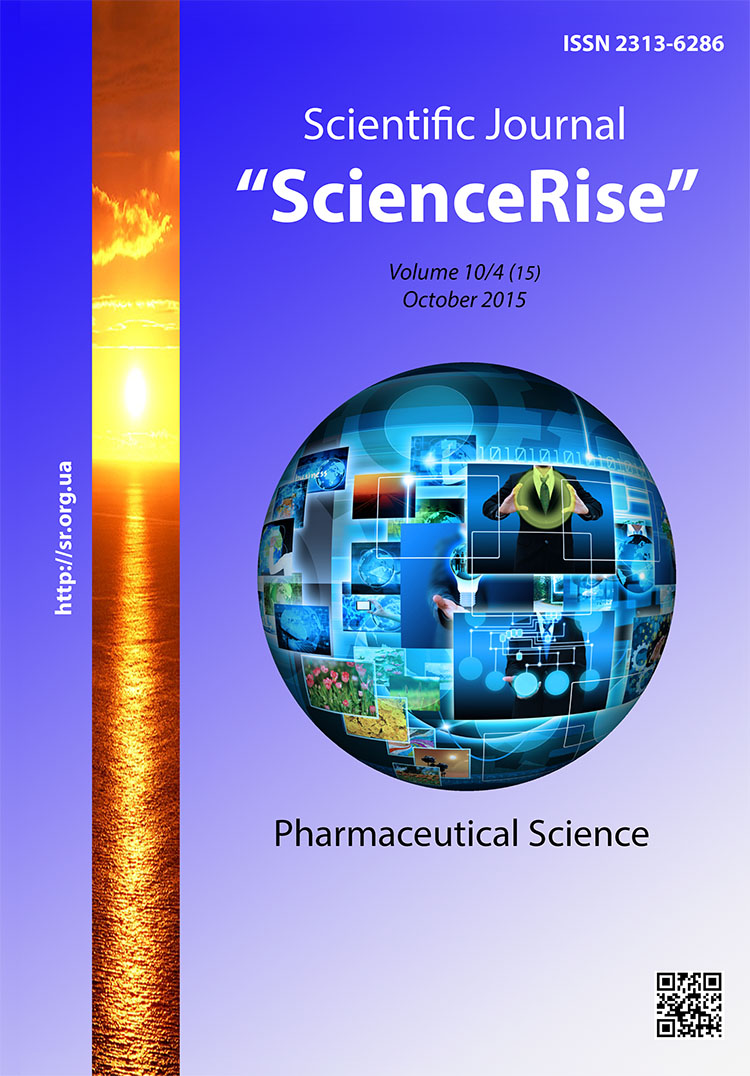Analytical review of modern herbal medicines used in musculoskeletal system diseases
DOI:
https://doi.org/10.15587/2313-8416.2015.52001Keywords:
musculoskeletal system diseases, review, nomenclature, pharmaceutical market, phytotheurapeutic remediesAbstract
Effective and safe treatment of the musculoskeletal system diseases is one of the main branches of medicine in general and rheumatology in particular. The relevance of this problem is caused mainly by the high incidence in the population, and temporary and permanent work disability status development in patients. The duration of rheumatologic diseases necessitates the optimal regimen selection, providing effective treatment and helping to prevent potential side effects associated with long-term use of remedies.
Aim of research. The aim of our research was to perform an analytical review of modern herbal products registered in Ukraine and used for musculoskeletal system treatment. The drug analysis was made according to next parameters: producing country, manufacturer, dosage form, and the origin of remedies (natural or synthetic).
Methods. Conventional analytical studies of electronic and paper sources were used for realization of the given problem.
Results. As a result of the analytical review of modern herbal remedies registered in Ukraine and used for musculoskeletal system treatment, it was found that 20 trade names of drugs, more than 90% of which are homeopathic, are displayed on the pharmaceutical market. Concerning dosage forms, pills (38,5 %), injection solutions and oral drops (23,1 % and 11,5 %, respectively) gain the biggest market share.
Conclusion. It was found that imported drugs are widely available (80 %) on the analyzed market segment, while local remedies gain rather minor market share (about 20 %).
Among medicines of this group presented on Ukrainian market, imported homeopathic remedies gain the biggest share. Phytotheurapeutic drugs gain minor market share and have limited composition of natural active ingredients represented by the extracts of Harpagophytum procumbens, Apium graveolens, Salix alba, and Zingiber officinale
References
Olynin ,A. Y. (2013). Hronicheskaya revmaticheskaya bol’. Osobennosti razviriya i principi lechenia [Chronic rheumatic pain. Features of development and principles of treatment]. Russion medical journal "Rheumatology", 6, 304–310.
Zupanets, I. A., Bezdetko, N. V., Usenko, V. A. (2002). Farmacevticheskaya opeka: Simptomaticheskoe lechenie systavnoj I mishechnoj boli [Pharmaceutical care: Symptomatic treatment of joint and muscle pain].Pharmacist, 12, 18–22.
State register of medicines of Ukraine. Available at: http://www.drlz.kiev.ua/
Listopad, A. Modern non-steroidal anti-inflammatory drugs on the pharmaceutical market of Ukraine. Available at: http://www.provisor.com.ua/archive/1999/N21/listopad.php
Fokina, N. M. (2013). NPVP: sistemnoe I local’noe primenenie (vibor specialistov) [nonsteroidal anti-inflammatory medications: systemic and local application (choice of professionals)] Russion medical journal "Rheumatology", 6, 320–322.
Legina, E. V. (2012). Hondroprotektori v lechenii octeoartroza [Chondroprotectors in the treatment of osteoarthritis]. Modern rheumatology, 2, 59–63.
Zagorіy, G. V., Dovzhuk, V. V. (2013). Doslidgennya medikamentoznogo zabezpechennya chvorih na revmatoidnij artrit [Research of medical support for the treatment of patients with rheumatoid arthritis in Ukraine]. Farmakom, 2, 56–60.
Fernandes, L., Hagen, K. B., Bijlsma, J. W. J., Andreassen, O., Christensen, P., Conaghan, P. G. et. al. (2013). EULAR recommendations for the non-pharmacological core management of hip and knee osteoarthritis. Annals of the Rheumatic Diseases, 72 (7), 1125–1135. doi: 10.1136/annrheumdis-2012-202745
Shpichak, O. S., Tihonov, A. I. (2014). Marketingovie issledovania farmacevticheskogo rinka preparatov, ispolzyemih mestno pri zabolevaniah oporno-dvigatelnogo apparata [Marketing research pharmaceutical market of medications used topically for diseases of the musculoskeletal apparatus]. News of Farmacy, 1, 63–68.
Kovalenko, V. I. (Ed.) (2014). Kompendium 2014 – Lekarstvennie prepereti [Compendium-2014 – medications]. Kyiv: MORION, 2448.
Savustyanenko, A. V. (2014). Effectivnost’ ecstracta martini dyshistoj (Systamar) pri osteoartritah, poyasnichnoj boli i fibromialgii: obzor assledovanij[Efficacy of the extract Harpagophytum procumbens (Sustamar) for osteoarthritis, fibromyalgia and low back pain: a review of research]. Pain. Joints. Spine, 1 (13), 30–38.
Downloads
Published
Issue
Section
License
Copyright (c) 2015 Анна Ігорівна Крюкова, Інна Миколаївна Владимирова

This work is licensed under a Creative Commons Attribution 4.0 International License.
Our journal abides by the Creative Commons CC BY copyright rights and permissions for open access journals.
Authors, who are published in this journal, agree to the following conditions:
1. The authors reserve the right to authorship of the work and pass the first publication right of this work to the journal under the terms of a Creative Commons CC BY, which allows others to freely distribute the published research with the obligatory reference to the authors of the original work and the first publication of the work in this journal.
2. The authors have the right to conclude separate supplement agreements that relate to non-exclusive work distribution in the form in which it has been published by the journal (for example, to upload the work to the online storage of the journal or publish it as part of a monograph), provided that the reference to the first publication of the work in this journal is included.

